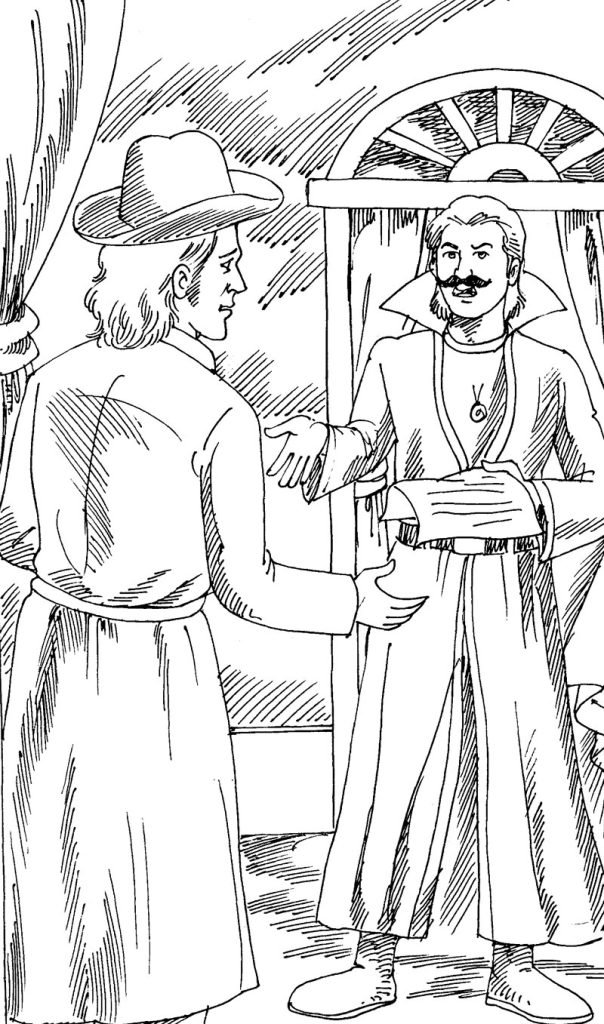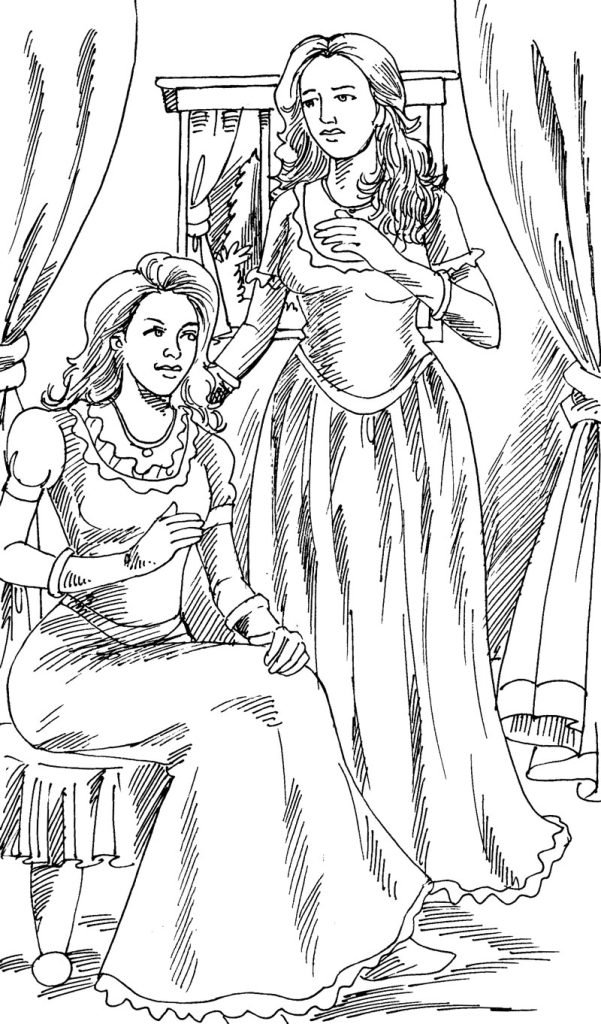Chapter 1
Taken from the May 16th, May 18th, May 19th, May 28th, May 31st, June 17th, June 24th, June 25th, June 29th, and June 30th entries of Jonathan Harker’s journal. Jonathan wakes up in his room. He searches the castle and finds the door he used to reach the hidden wing in which he saw the three women; the door is now bolted. He admits that his dream could not have been a dream. Later, the Count tells him to write three letters, dated June 12th, June 19th, and June 29th. The first will say that he is nearly done with his work, the second will say that he has left the castle, and third will say that he has arrived at Bistritz. Jonathan recognizes that the letters are meant to buy time for the Count, so that Jonathan’s loved ones may take some time to become suspicious when he does not return home. Horrified, he complies because he sees no alternative.

Gypsies have encamped in the courtyard of the castle. In an attempt to communicate with Mina, Jonathan drops letters with a piece of gold outside his window, hoping that a gypsy will take it to a post. The gypsy instead takes it to Dracula. The Count brings the letters before Jonathan, clearly having read the one to Peter Hawkins. The letter to Mina is in shorthand, which the Count cannot understand. Enraged, he burns it as Jonathan watches. Days later, Jonathan wakes up to discover that his clothes and papers have all been stolen. Almost a month later, in mid-June, Jonathan watches through a window as large square boxes are dropped off in the courtyard and loaded into the castle. No one heeds his cries for help. A week later, he sees the Count crawling down the castle wall again, this time in Jonathan’s clothes. Jonathan realizes that the Count, by appearing in Jonathan’s clothes, will provide sightings of Jonathan all the way back to Bistritz so that the Englishman’s disappearance may not be traced to Dracula’s castle. Jonathan also notices that the Count is carrying the same sack that was used to deliver the child to the three female vampires. Hours later, looking down through a window that faces the courtyard, Jonathan sees a woman who comes beating on the doors of the castle. She is screaming frantically, and calls out, “Monster, give me my child!” Jonathan hears Dracula whispering something from a tower high above, and a pack of wolves swarms through the gates and devours the woman.
Desperate, Jonathan attempts to scale the castle wall. He successfully makes it down to the window into the Count’s room. The room is empty except for a pile of ancient gold and jewelry. He wanders through hallways and down stairs, into the ruins of a chapel that has since been used as a burial ground. Jonathan finds the boxes that he earlier saw being delivered to the castle. The boxes are full of earth. In one of the boxes, on a pile of earth, the Count lies in a trance-like state. His eyes are open but he seems like one dead or asleep, and even though he does not move his eyes are fixed in an expression of hate. Jonathan flees and climbs back to his own room.
On June 29th, the date of the last false letter, the Count tells Jonathan that he is free to leave. He mockingly opens the door for Jonathan, but the courtyard outside is full of hungry wolves. Later that night, Jonathan hears the Count talking to the three vampire women; they are just outside of Jonathan’s door. The Count promises the three women that Jonathan is to be theirs the very next night.
June 30th is Jonathan’s final entry. He awakes just before dawn, only to discover that the exit from the castle will not budge. In a desperate search for the key, he scales the outside wall down into the Count’s room and the ruined chapel again. There he sees Dracula sleeping in a coffin, as still as before. But the Count looks much younger; his hair is no longer grey, and his skin is glowing with youthful vigour. He looks as though he has been feasting on a significant amount of blood. Jonathan grabs a nearby shovel to destroy the vampire, but when he strikes, Dracula’s head turns toward him and his hypnotic gaze makes Jonathan lose control, so that the shovel may strike far from the Count’s body. He goes back up to the Count’s room, and then hears the gypsies open a new entrance down in the vault, but as he tries to go down the stairs again, the door to the stairs is blown shut by a gust of wind. He hears the gypsies shutting all of the boxes (including the one in which Dracula sleeps) and carrying them off, to be transported all the way to England. Jonathan resolves to try and climb the wall down farther than he has ever attempted. He must escape before night falls. Jonathan believes that it would be better to fall to his death while attempting escape than to remain as prey for the undead.

Taken from letters between Mina Murray and Lucy Westenra, dated May 9th, May 17th, May 24th; also from the April 25th entry of Dr. Seward’s diary (kept in phonograph); a letter from Quincey P. Morris to Arthur Holmwood, dated May 25th; and a telegram from Arthur Holmwood to Quincey Morris, dated May 26th.
After the dark world discussed in the earlier text we are taken back to England and the correspondence between two beautiful and charming young women. Mina Murray and Lucy Westenra are dear friends, and the first part is in the form of letters between the two of them. Mina tells Lucy that she is interested in working at acquiring the skills of a lady journalist not for the sake of a career, but for her own betterment. She is going to keep a detailed journal, and she hopes to practise her powers of observation. She also reports that Jonathan will be returning home soon, according to a letter that she just received. This moment places a bit of dark dramatic irony into the bright world of the women. The reader knows, although Lucy and Mina do not, that Jonathan is actually in great danger and that the letter Mina received was a false one, extracted from her husband and sent by a monster.
Lucy reports that she received three marriage proposals in a day, although her heart truly belongs to Arthur Holmwood. Dr. John Seward, the director of a lunatic asylum, and Quincey Morris, a wealthy Texan adventurer, are both rejected by Lucy in favour of Arthur Holmwood, a handsome young man who has been friends with Lucy since they were both children.
Dr. Seward reports in his diary that he has been feeling low since his rejection by Lucy, but his work has been made more interesting by a madman named Renfield who is under his care. Quincey’s letter to Arthur is one of congratulations, inviting him to join Quincey and Dr. Seward for a night of drinking. Arthur sends a telegram saying that he will be there.
Taken from the July 24th and August 1st entries of Mina Murray’s journal; the June 5th, June 18th, July 1st, July 8th, July 19th, July 20th; the July 26th, July 27th, and August 3rd, August 6th entries of Mina Murray’s journal.
As Mina said she would, she keeps a diary during her visit to Lucy. The two women are in the quaint seaside town of Whitby, on the northeast coast of England. She describes the beauty of the area and it’s quaint provincial history. There is a ruined abbey near by that is supposedly haunted by a “white lady.” The town church has a large graveyard, but the grounds are pleasant and the view is beautiful. Many townspeople go on strolls there during the day. Lucy and Mina become friends with a gruff, nonsensical local named Mr. Swales. He is a grandfatherly figure, speaking in dialect and full of provincial wisdom. He knows a good deal of the local history, and Mina and Lucy spend long hours talking to him about the area. However, Mina sorely misses Jonathan. He is not yet home, nor has he written for a long time.
Dr. Seward reports on the strange behaviour of Renfield. Renfield is fascinated by animals that devour each other. He catches flies and feeds them to spiders, and he also eats the insects himself. He catches some sparrows and begins feeding the spiders to them, and he eventually asks Dr. Seward if he can have a kitten. Dr. Seward refuses. The next day, the sparrows are gone. Dr. Seward asks where they went, and Renfield responds cryptically that they all “flew away,” but there are feathers around the room and blood on Renfield’s pillow. Later, he vomits up feathers. Seward invents a new classification for Renfield, calling him a “zoophagous” (life-eating) maniac. Renfield seeks to “absorb as many lives as he can”. Dr. Seward’s journal reveals a wish to experiment further on Renfield, although the idea seems to trouble him ethically. And he expresses a wistful envy for Renfield, because the madman has a purpose. Dr. Seward is still depressed about his rejection by Lucy, and is trying to throw himself into work.
In Whitby, Mina is growing more worried about Jonathan and Lucy. Jonathan has not written, and Lucy has returned to her old childhood habit of sleepwalking. Lucy encounters Mr. Swales while she is out on a walk, and the old man tells her that he senses his own death is nigh. At that moment, they see a great ship out at sea, moving as if no one were at the helm.
Analysis
In Gothic literature, the battle between well-defined forces of good and evil frequently dominates plots. In Dracula, that battle is largely waged over the fate of its female protagonists, Lucy Westenra and Mina Murray. Neither Mina nor Lucy is a particularly profound character. Instead, both represent the Victorian ideal of female virtue. The two sets of women we have seen thus far in the novel stand in stark and obvious opposition to each other: Lucy and Mina represent purity and goodness, while the predatory sisters in Dracula’s castle represent corruption and evil. The count threatens womanly virtue, as the frighteningly voluptuous sisters testify to his ability to transform ladies into sex-crazed “devils of the Pit.”
Both Lucy and Mina face the threat of such transformation later in the novel. It is perhaps no surprise that, of the two, Lucy falls most disastrously under Dracula’s spell. Although Lucy’s letters pay homage to a certain male fantasy of domination—“My dear Mina, why are men so noble when we women are so little worthy of them?”—they also reveal that she is a sexualized being. Lucy is not only an object of desire who garners three marriage proposals in a single day, but is herself capable of desiring others. Lucy writes: “Why can’t they let a girl marry three men, or as many as want her, and save all this trouble?” Though Lucy immediately condemns her own words as “heresy,” her apology does not blot out her desire to experience life beyond the narrow confines of conventional morality.
Mina and Lucy’s correspondence contrasts sharply with the terror-filled journal entries that comprise the first four chapters. The London society that Mina, Lucy, and Dr. Seward inhabit is marked by order, reason and progress: Mina is a schoolmistress who occupies herself with shorthand and typewriting lessons, while Seward, ever hopeful of diagnosing and curing his mentally ill patients, records his diary entries on a new-fangled phonograph. The world that Dracula inhabits, in contrast, is ruled by the seemingly impossible or unexplainable: people neither age nor die, and men crawl down sheer walls. Dracula’s foreign presence threatens to overturn the whole of Western culture by subverting carefully constructed and policed morals and by allowing superstition to trump logic.
Lucy’s and Mina’s letters also introduce most of the main characters we see in the remainder of the novel. Lucy describes her three suitors, who are largely two-dimensional characters: Seward is a serious intellectual, Quincey Morris a slang-talking Texan, and Arthur Holmwood is a bland nobleman. Stoker is more concerned with creating a band of men whose goodness is unquesti-onable than with creating complex, multi-faceted characters. This characterization sets up a framework for a clear-cut moral battle later in the novel.
The colourful character of Mr. Swales is noteworthy for two reasons. First, as an unapologetic sceptic, Swales stands in contrast to the Eastern European peasants, whose lives are ruled by superstitions. When Mina directs their conversation to local legends, Swales responds, “It be all fool-talk, lock, stock and barrel; that’s what it be, an’ nowt else.” Though uneducated, Swales stands as a product of Western society: he is too committed to reason to allow for the existence of “bans an’ wafts an’ boh-ghosts an’ barguests an’ bogles.” Swales is also noteworthy because he exemplifies Stoker’s dedication to capturing regional dialects. Van Helsing and many of the novel’s secondary characters speak with heavy accents that the author transcribes carefully. But some critics have pointed out that Stoker relies less on a precise ear than on stereotype to generate his characters’ dialogue. For instance, Quincey’s proposal to Lucy Westenra reads like a parody of the language patterns of the American South: “Miss Lucy, I know I ain’t good enough to regulate the fixin’s of your little shoes, but . . . won’t you just hitch up alongside of me and let us go down the long road together, driving in double harness?”
Another significant character introduced in this section is Renfield, Dr. Seward’s “zoöphagous” maniac. Renfield’s consumption of flies, spiders, and sparrows is spurred by his belief that their lives are transferred into his own, providing him with strength and vitality. Renfield’s habit mirrors the count’s means of sustenance and confirms Stoker’s concern with the relationship between humans and beasts. From a psychoanalytic standpoint, the desire to consume is a primal urge to incorporate an object into one’s self and at the same time to destroy the object.
Largely because of the relatively recent publication of Charles Darwin’s The Origin of Species (1859) and The Descent of Man (1871), Victorian society was anxious about such primal urges, seeking to keep them hidden beneath the veneers of science, art, and polite conversation. Darwin’s works questioned the century-old belief in creationism and toppled the previously unassailable hierarchy of man over beast. Humans were no longer the undisputed crown of creation—they were merely another link in a great chain. Although the last decades of the eighteenth and first decades of the nineteenth century were ripe with scientific advancements yet they were also marked by a profound sense of uneasiness at having to abandon old and refuted, but nevertheless comfortable, modes of thought. Thus, because it confirms the animalistic and possibly savage nature of human beings, Renfield’s behaviour would have caused no small shock among Stoker’s original readers. In Seward’s lunatic, we see how fine a line separates the beast from the drawing-room dandy.
